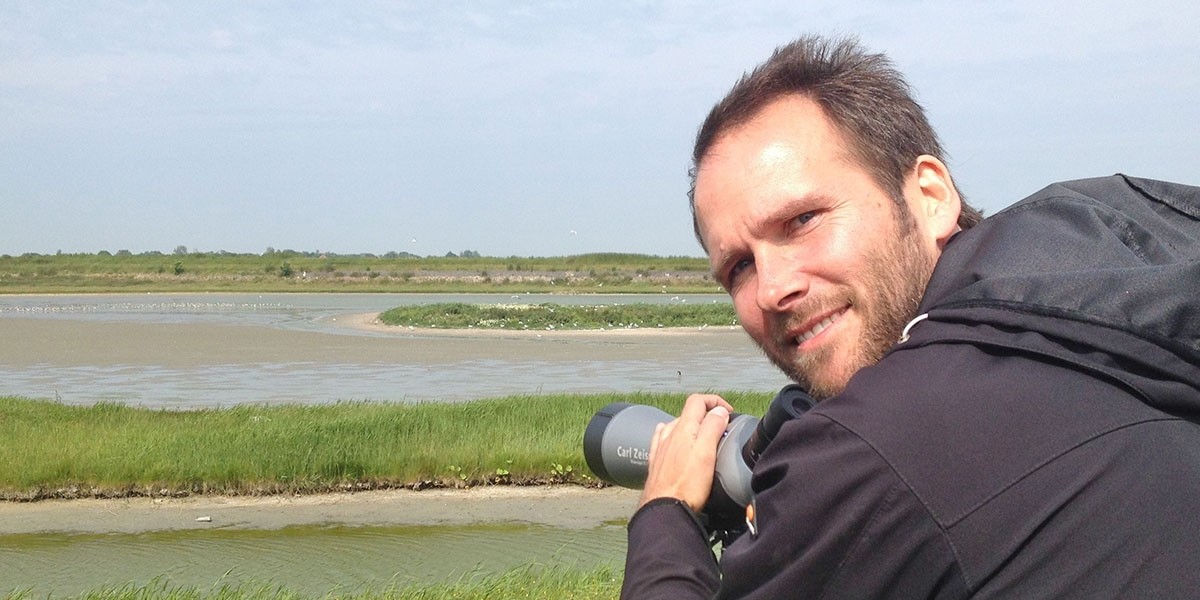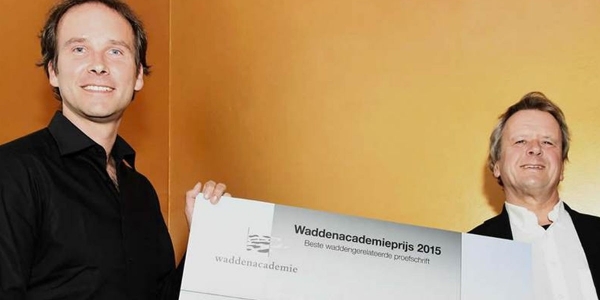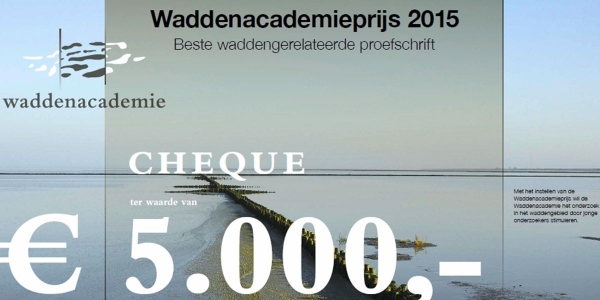Dr. Allert Bijleveld
'Tracking animal movement in a changing and dynamic environment'
Behavioural ecologist Allert Bijleveld studies how animals adapt to the changing and dynamic tidal environment of the Wadden Sea. He is particularly interested in animal movement and spatial distributions. ‘Where do birds and fish go, and where do they find their food? How do birds adapt to sea level rise and land subsidence due to gas or salt extraction when intertidal mudflats become inaccesible for finding food? How long do fish stay in the Wadden Sea while migrating from lake IJssel to the English Channel? What are hotspots for biodiversity of worms, shellfish and shrimp living in and on the intertidal mudflats? The answers to questions like these will tell us what areas are crucial and what animals will get into trouble due to human activities, such as mining, fishing, and climate change.’
Ideal model
‘One of my study species are Red Knots. These are shorebirds that breed in the Arctic and winter in Europe and Africa. Because we have studied them for so long, they have now become an ideal model system that can also help us understand other animals, even fish. The interaction between an animal and its environment is, by definition, complex, and so it is good to work with a species that we already know a lot about. Red Knots feed on shellfish, such as small cockles and Balthic tellins, that they swallow whole and crush in their muscular gizzard. If there is one thing that we have learned in these years, it is the intricate relationship between Red Knots and their food. When less food is available, for instance due to shell fisheries or land subsidence, shorebirds will disappear. In the past decades, we have seen that the numbers of Red Knots in this part of the world - the so-called flyway population – have not changed. Red Knots that had settled in the Dutch Wadden Sea could so-far – thankfully – find an alternative elsewhere.'
Baseline
To know how animals adapt to a changing world, you also need to know how they would normally behave in a steady environment. And this is almost a contradiction: the Wadden Sea is dynamic and per definition not steady. Moreover, we have learned that, even within species, there are huge differences between individuals. Some individuals are very cautious, and other fly huge distances per tide in search of food.
‘My research is mainly driven by an intrinsic fascination for the dynamic Wadden Sea. I am convinced that if one persists with that fundamental, curiosity-driven research for long enough, then practical applications will always emerge. For example, already Red Knots teach us about how nature responds to the changes that we cause in their world.’
More information about the work of Allert Bijleveld can be found here.
Read more +
Research interests
I am a behavioural ecologist focussed on studying consistent individual differences (animal personality), social behaviour, and trophic interactions in coastal ecosystems. Particularly, I am interested in studying how different phenotypes interact with the environment to shape movement, spatial distributions and fitness. In my studies, I combine experiments, modelling, field observations, and the latest tracking technologies. I have mainly studied marine macrozoobenthos and birds, but I will expand my research to include fish.
If you are interested in a project or a collaboration with me, please feel free to send me an e-mail or contact me on Twitter @AllertBijleveld.
Functions
2017 - present: Tenure-track scientist at NIOZ
2016 - 2017: Visiting academic at the University of Oxford
2015 - 2017: Post-doctoral researcher at NIOZ
2007-2009: Project-researcher at NIOZ
2003-2007: Teaching assistent at the University of Amsterdam
Publications
Please find my list of publications at the bottom of this webpage or on GoogleScholar. You can download all my publications on ResearchGate.
Professional education
2009-2015: PhD - Untying the knot: Mechanistically understanding the interactions between social foragers and their prey. NIOZ / University of Groningen (cum laude)
2007: MSc Ecology & Evolution, University of Amsterdam with a specialization in Animal Ecology (cum laude)
2006: BSc General Biology, University of Amsterdam
Awards and Prizes
2015: Wadden Academy Prize for best PhD thesis in the academic years 2013/14 and 2014/15 (5 k€)
Research video's
Do Red Knots use each other to find their hidden food?
The video below shows an experiment that we designed to answer this question. In the Experimental Shorebird Facility we constructed two patches and burried food in only one. We then released two Red Knots on each patch. We also released a focal bird in a central cage that was located in between the two patches. This bird was then allowed to watch the two groups of foraging birds on both sides. After 2 minutes the central cage was opened and the focal bird was allowed to exit to either side. The results show that in 75% of the trials Red Knots chose that side of the experimental arena where the food was buried. This show that Red Knots can use social information to be more efficient in finding their hidden food. You can find the scientific publication here.
Red knot foraging experiment
Here is a movie that shows the experimental setup for a foraging experiment on Red Knots (Calidris canutus islandica). The experiment was designed to study patch departure decisions for red knots foraging in a patchy food environment. Foragers should not stay in a patch too long and waste time searching for that last prey item while other food patches have more to offer. On the other hand, foragers should not depart a patch too soon and leave many prey items behind. Depending on the density and distribution of food, one can calculate the optimal departure decision that foragers should use that maximises intake rate. We want to find out how and if red knots make optimal foraging decisions.
The movie below shows two golden plovers that we tracked with our novel 'time-of-arrival' methodology. This movie is part of our publication in LIMOSA.
Linked news
Linked blogs
NIOZ publications
-
2024
Colina Alonso, A.; Van Maren, D.S.; Oost, A.P.; Esselink, P.; Lepper, R.; Kösters, F.; Bartholdy, J.; Bijleveld, A.I.; Wang, Z.B. (2024). A mud budget of the Wadden Sea and its implications for sediment management. Commun. Earth Environ. 5(1): 153. https://dx.doi.org/10.1038/s43247-024-01315-9de la Barra, P.; Aarts, G.M; Bijleveld, A. (2024). The effects of gas extraction under intertidal mudflats on sediment and macrozoobenthic communities. J. Appl. Ecol. 61(2): 390-405. https://dx.doi.org/10.1111/1365-2664.14530Edwards, J.E.; Buijse, A.D.; Winter, H.V.; Bijleveld, A.I. (2024). Gone with the wind: environmental variation influences detection efficiency in a coastal acoustic telemetry array. Animal Biotelemetry 12(1): 21. https://dx.doi.org/10.1186/s40317-024-00378-xEdwards, J.E.; Buijse, A.D.; Winter, H.V.; Van Leeuwen, A.; Bijleveld, A.I. (2024). A multi-scale tracking approach for conserving large migratory fish in an open coastal environment. Est., Coast. and Shelf Sci. 301: 108737. https://dx.doi.org/10.1016/j.ecss.2024.108737
-
2023
Folmer, E.O.; Bijleveld, A.; Holthuijsen, S.; van der Meer, J.; Piersma, T.; van der Veer, H. (2023). Space–time analyses of sediment composition reveals synchronized dynamics at all intertidal flats in the Dutch Wadden Sea. Est., Coast. and Shelf Sci. 285: 108308. https://dx.doi.org/10.1016/j.ecss.2023.108308Kwakernaak, C.; Hoeijmakers, D.J.J.; Zwarts, M.P.A.; Bijleveld, A.I.; Holthuijsen, S.; de Jong, D.J.; Govers, L.L. (2023). Ragworms (Hediste diversicolor) limit eelgrass (Zostera marina) seedling settlement: Implications for seed-based restoration. J. Exp. Mar. Biol. Ecol. 560: 151853. https://dx.doi.org/10.1016/j.jembe.2022.151853Madhuanand, L.; Philippart, C.J.M.; Wang, J.; Nijland, W.; de Jong, S.M.; Bijleveld, A.I.; Addink, E.A. (2023). Enhancing the predictive performance of remote sensing for ecological variables of tidal flats using encoded features from a deep learning model. Giscience & Remote Sensing 60(1). https://dx.doi.org/10.1080/15481603.2022.2163048Nuijten, R.J.M.; Katzner, T.E.; Allen, A.M.; Bijleveld, A.I.; Boorsma, T.; Börger, L.; Cagnacci, F.; Hart, T.; Henley, M.A.; Herren, R.M.; Kok, E.M.A.; Maree, B.; Nebe, B.; Shohami, D.; Vogel, S.M.; Walker, P.; Heitkönig, I.M.A.; Milner-Gulland, E.J. (2023). Priorities for translating goodwill between movement ecologists and conservation practitioners into effective collaboration. Conservation Science and Practice 5(1): e12870. https://dx.doi.org/10.1111/csp2.12870Peng, H.-B.; Choi, C.-Y.; Ma, Z.; Bijleveld, A.I.; Melville, D.S.; Piersma, T. (2023). Individuals of a group-living shorebird show smaller home range overlap when food availability is low. Movement Ecology 11(1). https://dx.doi.org/10.1186/s40462-023-00427-9Singer, A.; Bijleveld, A.I.; Hahner, F.; Holthuijsen, S.; Hubert, K.; Kerimoglu, O.; Kleine Schaars, L.; Kröncke, I.; Lettmann, K.A.; Rittweg, T.; Scheiffarth, G.; van der Veer, H.W.; Wurpts, A. (2023). Long-term response of coastal macrofauna communities to de-eutrophication and sea level rise mediated habitat changes (1980s versus 2018). Front. Mar. Sci. 9: 963325. https://dx.doi.org/10.3389/fmars.2022.963325
-
2022
Beardsworth, C.E; Gobbens, E.; van Maarseveen, F.; Denissen, B.; Dekinga, A.; Nathan, R.; Toledo, S.; Bijleveld, A.I. (2022). Validating
ATLAS : A regional‐scale high‐throughput tracking system. Methods Ecol. Evol. 13(9): 1990-2004. https://dx.doi.org/10.1111/2041-210x.13913Bijleveld, A.I.; van Maarseveen, F.; Denissen, B.; Dekinga, A.; Penning, E.; Ersoy, S.; Gupte, P.R.; de Monte, L.; ten Horn, J.; Bom, R.A.; Toledo, S.; Nathan, R.; Beardsworth, C.E. (2022). WATLAS: high-throughput and real-time tracking of many small birds in the Dutch Wadden Sea. Animal Biotelemetry 10: 36. https://dx.doi.org/10.1186/s40317-022-00307-wColina Alonso, A.; van Maren, D.S.; Herman, P.M.J.; van Weerdenburg, R.J.A.; Huismans, Y.; Holthuijsen, S.J.; Govers, L.L.; Bijleveld, A.I.; Wang, Z. (2022). The existence and origin of multiple equilibria in sand‐mud sediment beds. Geophys. Res. Lett. 49(22): e2022GL101141. https://dx.doi.org/10.1029/2022gl101141Ersoy, S.; Beardsworth, C.E.; Dekinga, A.; van der Meer, M.T.J.; Piersma, T.; Groothuis, T.G.G.; Bijleveld, A.I. (2022). Exploration speed in captivity predicts foraging tactics and diet in free‐living red knots. J. Anim. Ecol. 91(2): 356-366. https://dx.doi.org/10.1111/1365-2656.13632Gupte, P.R.; Beardsworth, C.E.; Spiegel, O.; Lourie, E.; Toledo, S.; Nathan, R.; Bijleveld, A.I. (2022). A guide to pre‐processing high‐throughput animal tracking data. J. Anim. Ecol. 91(2): 287-307. https://dx.doi.org/10.1111/1365-2656.13610Klunder, L.; van Bleijswijk, J.D.L.; Kleine Schaars, L.; van der Veer, H.W.; Luttikhuizen, P.C.; Bijleveld, A. (2022). Quantification of marine benthic communities with metabarcoding. Mol. Ecol. Resour. 22(3): 1043-1054. https://dx.doi.org/10.1111/1755-0998.13536Nathan, Ran; Monk, Christopher T.; Arlinghaus, Robert; Adam, Timo; Alós, Josep; Assaf, Michael; Baktoft, Henrik; Beardsworth, Christine E.; Bertram, Michael G.; Bijleveld, Allert I.; Brodin, Tomas; Brooks, Jill L.; Campos-Candela, Andrea; Cooke, Steven J.; Gjelland, Karl Ø.; Gupte, Pratik R.; Harel, Roi; Hellström, Gustav; Jeltsch, Florian; Killen, Shaun S.; Klefoth, Thomas; Langrock, Roland; Lennox, Robert J.; Lourie, Emmanuel; Madden, Joah R.; Orchan, Yotam; Pauwels, Ine S.; Říha, Milan; Roeleke, Manuel; Schlägel, Ulrike E.; Shohami, David; Signer, Johannes; Toledo, Sivan; Vilk, Ohad; Westrelin, Samuel; Whiteside, Mark A.; Jarić, Ivan (2022). Big-data approaches lead to an increased understanding of the ecology of animal movement. Science (Wash.) 375(6582): 1-14. https://dx.doi.org/10.1126/science.abg1780 -
2021
Bakker, W.J.; Ens, B.J.; Dokter, A.M.; van der Kolk, H.-J.; Rappoldt, K.; van de Pol, M.; Troost, K.; van der Veer, H.W.; Bijleveld, A.I.; van der Meer, J.; Oosterbeek, K.; Jongejans, E.; Allen, A.M. (2021). Connecting foraging and roosting areas reveals how food stocks explain shorebird numbers. Est., Coast. and Shelf Sci. 259: 107458. https://doi.org/10.1016/j.ecss.2021.107458Foekema, E.; van der Molen, J.; Asjes, A.; Bijleveld, A.; Brasseur, S.; Camphuysen, K. (C.J.); Van Franeker, J.A.; Holthuijsen, S.; Kentie, R.; Kühn, S.; Leopold, M.; Kleine Schaars, L.; Lok, T.; Niemann, H.; Schop, J. (2021). Ecologische effecten van het incident met de MSC Zoe op het Nederlandse Waddengebied, met focus op microplastics. NIOZ-rapport, 2021(03). NIOZ Royal Netherlands Institute for Sea Research: Texel. 98 pp. https://doi.org/10.25850/nioz/7b.b.mbHerman, P.; van der Lelij, A.C.; Ieno, E.N.; Leopold, M.; Schekkerman, H.; Troost, K.; Craeymeersch, J.; Bijleveld, A.; van de Bogaart, L. (2021). Statistical analysis of effects of MSC Zoe incident on populations of protected species in Wadden Sea and North Sea. 11206109-000-ZKS-0004. Versie 1.0. Deltares: [s.l.]. 165 pp.Kleefstra, R.; Bijleveld, A.I.; van Dijk, A.-J.; van Els, P.; Folmer, E.; van Turnhout, C.; van Winden, E. (2021). Overwinterende en doortrekkende Wulpen in Nederland: trends in aantallen en verspreiding sinds de jaren zeventig. Limosa (Amst.) 94: 44-57Lameris, T.K.; Hoekendijk, J.; Aarts, G.; Aarts, A.; Allen, A.M.; Bienfait, L.; Bijleveld, A.I.; Bongers, M.F.; Brasseur, S.; Chan, Y.-C.; de Ferrante, F.; de Gelder, J.; Derksen, H.; Dijkgraaf, L.; Dijkhuis, L.R.; Dijkstra, S.; Elbertsen, G.; Ernsten, R.; Foxen, T.; Gaarenstroom, J.; Gelhausen, A.; van Gils, J.A.; Grosscurt, S.; Grundlehner, A.; Hertlein, M.L.; van Heumen, A.J.P.; Heurman, M.; Huffeldt, N.P.; Hutter, W.H.; Kamstra, Y.J.J.; Keij, F.; van Kempen, S.; Keurntjes, G.; Knap, H.; Loonstra, A.H.J.; Nolet, B.A.; Nuijten, R.J.M.; Mattijssen, D.; Oosterhoff, H.; Paarlberg, N.; Parekh, M.; Pattyn, J.; Polak, C.; Quist, Y.; Ras, S.; Reneerkens, J.; Ruth, S.; van der Schaar, E.; Schroen, G.; Spikman, F.; van Velzen, J.; Voorn, E.; Vos, J.; Wang, D.; Westdijk, W.; Wind, M.; Zhemchuzhnikov, M.K.; van Langevelde, F. (2021). Migratory vertebrates shift migration timing and distributions in a warming Arctic. Animal Migration 8(1): 110-131. https://dx.doi.org/10.1515/ami-2020-0112
-
2020
Börger, L.; Bijleveld, A.; Fayet, A.L.; Machovsky-Capuska; Patrick, S.C.; Street; Vander Wal (2020). Biologging special feature. J. Anim. Ecol. 89(1): 6-15. https://dx.doi.org/10.1111/1365-2656.13163Williams, H.J.; Taylor, L.A.; Benhamou, S.; Bijleveld, A.I.; Clay, T.A.; de Grissac, S.; Demšar, U.; English, H.M.; Franconi, N.; Gómez-Laich, A.; Griffiths, R.C.; Kay, W.P.; Morales, J.M.; Potts, J.R.; Rogerson, K.F.; Rutz, C.; Spelt, A.; Trevail, A.M.; Wilson, R.P.; Börger, L. (2020). Optimizing the use of biologgers for movement ecology research. J. Anim. Ecol. 89(1): 186-206. https://dx.doi.org/10.1111/1365-2656.13094
-
2019
MacCurdy, R.B.; Bijleveld, A.I.; Gabrielson, R.M.; Cortopassi, K.A. (2019). Automated wildlife radio tracking, in: Zekavat, R. et al. (Ed.) Handbook of position location: Theory, practice, and advances, 2nd Edition. pp. 1219-1261. https://dx.doi.org/10.1002/9781119434610.ch33
-
2018
Bijleveld, A.I.; Compton, T.J.; Klunder, L.; Holthuijsen, S.; ten Horn, J.; Koolhaas, A.; Dekinga, A.; Van der Meer, J.; van der Veer, H.W. (2018). Presence-absence of marine macrozoobenthos does not generally predict abundance and biomass. NPG Scientific Reports 8(1): 12. https://dx.doi.org/10.1038/s41598-018-21285-1Oudman, T.; Piersma, T.; Ahmedou Salem, M.V.; Feis, M.E.; Dekinga, A.; Holthuijsen, S.; ten Horn, J.; van Gils, J.A.; Bijleveld, A.I. (2018). Resource landscapes explain contrasting patterns of aggregation and site fidelity by red knots at two wintering sites. Movement Ecology 6(24). https://doi.org/10.1186/s40462-018-0142-4
-
2017
Bijleveld, A.; van der Heide, T.; Speelman, H.; Philippart, K.; Vellinga, P. (2017). Audit Bodemdalingscommissie Ameland 1986-2016. in het bijzonder de periode 2011-2016. Waddenacademie: Leeuwarden. 17 pp.Bulla, M.; Oudman, T.; Bijleveld, A.I.; Piersma, T.; Kyriacou, C.P. (2017). Marine biorhythms : bridging chronobiology and ecology. Phil. Trans. R. Soc. Lond. (B Biol. Sci.) 372(1734): 20160253. https://dx.doi.org/10.1098/rstb.2016.0253
-
2016
Bijleveld, A.I.; Folmer, E. (2016). Wat verklaart de grootschalige ecologische ontwikkelingen in de Waddenzee? : Implicaties voor monitoring, onderzoek en beleid, in: Visies op de Wadden : Zes essays ten behoeve van de Beleidsverkenning ToekomstigeRol en Ambitie van het Rijk voor het Waddengebied.Bijleveld, A.I.; MacCurdy, R.B.; Chan, Y.-C; Penning, E.; Gabrielson, R.M.; Cluderay, J.; Spaulding, E.L.; Dekinga, A.; Holthuijsen, S.; Ten Horn, J.; Brugge, M.; van Gils, J.A.; Winkler, D.W.; Piersma, T. (2016). Understanding spatial distributions: negative density-dependence in prey causes predators to trade-off prey quantity with quality. Proc. - Royal Soc., Biol. Sci. 283: 1828. https://dx.doi.org/10.1098/rspb.2015.1557Oudman, T.; Bijleveld, A.I.; Kavelaars, M.M.; Dekinga, A.; Cluderay, J.; Piersma, T.; van Gils, J.A. (2016). Diet preferences as the cause of individual differences rather than the consequence. J. Anim. Ecol. 85(5): 1378-1388. https://dx.doi.org/10.1111/1365-2656.12549
-
2015
Bijleveld, A.I. (2015). Untying the knot: mechanistically understanding the interactions between social foragers and their prey. PhD Thesis. NIOZ: Texel. ISBN 978-90-367-7866-4. 259 pp. hdl.handle.net/11370/cba07229-1ddc-476d-8d93-e9574cbe6685Bijleveld, A.I.; Twietmeyer, S.; Piechocki, J.; van Gils, J.A.; Piersma, T. (2015). Natural selection by pulsed predation: survival of the thickest. Ecology 96(7): 1943-1956. dx.doi.org/10.1890/14-1845.1Bijleveld, A.I.; van Gils, J.A.; Jouta, J.; Piersma, T. (2015). Benefits of foraging in small groups: An experimental study on public information use in red knots Calidris canutus. Behav. Process. 117: 74-81. dx.doi.org/10.1016/j.beproc.2014.09.003
-
2014
Bijleveld, A.I.; Massourakis, G.; van der Marel, A.; Dekinga, A.; Spaans, B.; van Gils, J.A.; Piersma, T. (2014). Personality drives physiological adjustments and is not related to survival. Proc. - Royal Soc., Biol. Sci. 281: 20133135. dx.doi.org/10.1098/rspb.2013.3135Piersma, T.; MacCurdy, R.B.; Gabrielson,, R.M.; Dekinga, A.; Cluderay, J.; Spaulding, E.L.; Oudman, T.; van Gils, J.; Winkler, D.; Bijleveld, A. (2014). Fijnmazige positiebepaling van individuen in groepen : de principes en drie toepassingen van TOA-tracking. Limosa (Amst.) 87: 156-176
-
2012
Bijleveld, A.I.; Folmer, E.O.; Piersma, T. (2012). Experimental evidence for cryptic interference among socially foraging shorebirds. Behav. Ecol. 23(4): 806-814. dx.doi.org/10.1093/beheco/ars034Bijleveld, A.I.; van Gils, J.A.; van der Meer, J.; Dekinga, A.; Kraan, C.; van der Veer, H.W.; Piersma, T. (2012). Designing a benthic monitoring programme with multiple conflicting objectives. Methods Ecol. Evol. 3(3): 526-536. dx.doi.org/10.1111/j.2041-210X.2012.00192.x

